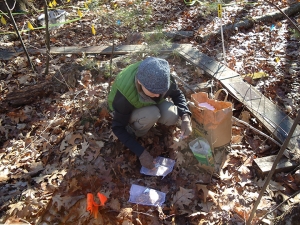You are here
New Study: Nitrogen Pollution Hinders Forest Decomposers
Atmospheric pollution may be altering forest ecosystems in ways that are difficult to reverse, according to a study of experimental Harvard Forest soils recently published in the journal Ecology, led by a team of HF collaborators from the University of New Hampshire, University of Wyoming, and University of Wisconsin-Madison.
The study is the first to investigate a three-part domino-effect: long-term exposure to pollution causes organisms to evolve, altering their growth habits and functions, in turn altering the ecosystem processes that those organisms control.
 The team focused their study on a group of tiny organisms with a disproportionately large impact on the ecosystem: soil fungi. “They are the recyclers of the ecosystem—the primary decomposers of wood, leaves, and other plant material,” said Serita Frey, Professor of Natural Resources and the Environmental at the University of New Hampshire, a lead author on the study and a co-investigator on the Harvard Forest Long-Term Ecological Research project. Without them, Frey said, dead material would not be broken down: “We would be buried in leaves and wood, and no new nutrients would be made available for plants to use.”
The team focused their study on a group of tiny organisms with a disproportionately large impact on the ecosystem: soil fungi. “They are the recyclers of the ecosystem—the primary decomposers of wood, leaves, and other plant material,” said Serita Frey, Professor of Natural Resources and the Environmental at the University of New Hampshire, a lead author on the study and a co-investigator on the Harvard Forest Long-Term Ecological Research project. Without them, Frey said, dead material would not be broken down: “We would be buried in leaves and wood, and no new nutrients would be made available for plants to use.”
Soil fungi are sensitive to environmental stress, and they evolve quickly in new conditions. In the lab, the team analyzed soil fungi samples, half reared in petri dishes polluted with nitrogen as an environmental stressor.
But there was a twist. Some of the fungi samples were polluted to begin with – collected from a long-term study area at the Harvard Forest, where for the past 28 years, nitrogen had been added to simulate chronic industrial pollution.
After 14 weeks in the lab, the scientists were surprised to find that fungi samples with a long history of pollution behaved differently than those from unpolluted soil: the polluted samples were stymied in their ability to perform decomposition, their primary function in the ecosystem. “The fungi from polluted plots had evolved,” said Frey. “They weren’t decomposing as much plant material as the same species collected from a less polluted area. Something about the organism had changed in a fundamental way.”
What’s more, even when grown in an unpolluted petri dish, fungi from polluted areas weren’t able to match the decomposition function of their neighbors from cleaner soils.
Some species of fungi were more sensitive than others—particularly a species called Irpex, which decomposed up to 44 percent less plant material after being polluted long-term. This fungus is from a subset of fungi that decompose wood. “Only a small subset of fungi can actually decompose wood,” said Frey. “It’s troubling to see this group so affected.”
Because decomposition is central to ecosystem function, the scientists say, a critical next question is determining whether, and how, fungal communities can recover after long-term nitrogen pollution. Nitrogen pollution deposited on Earth's ecosystems from the atmosphere has increased 200 percent since the beginning of the Industrial Revolution. Anne Pringle, Associate Professor of Botany and Bacteriology at the University of Wisconsin-Madison and a co-author on the study, added, "As long as nitrogen pollution continues to be a feature of our rapidly changing world, the evolution of fungi will likely shape how ecosystems function."
- Read the full scientific paper in Ecology: Fungi exposed to chronic nitrogen enrichment are less able to decay leaf litter
- For follow-up media interviews with the scientists, contact Clarisse Hart, HF Outreach Manager, at hart3@fas.harvard.edu or 978-756-6157.
- Learn more about long-term climate studies at Harvard Forest.

